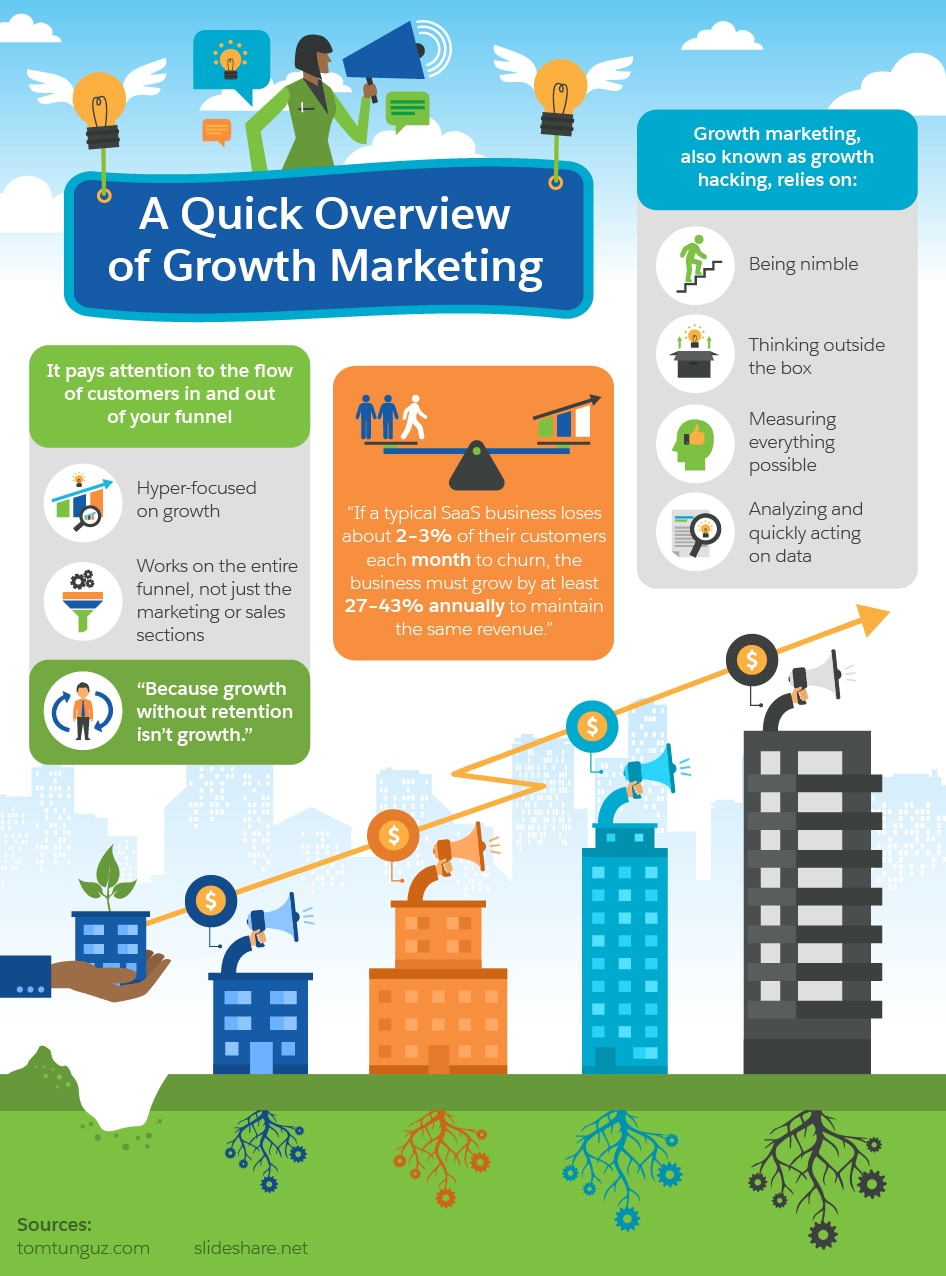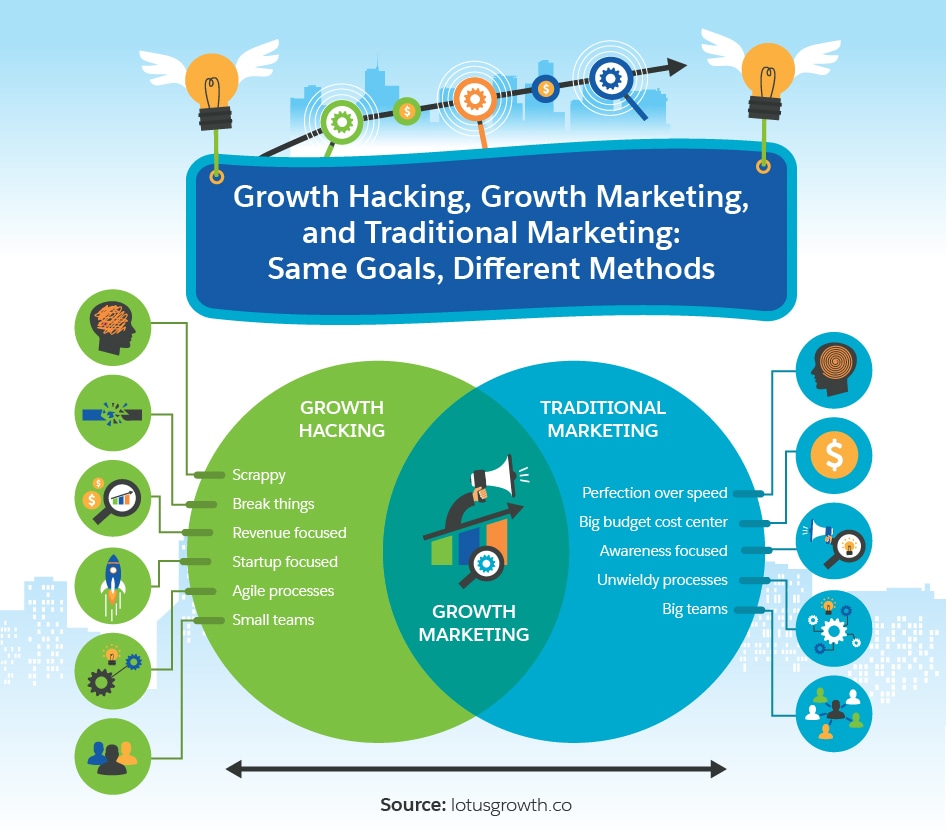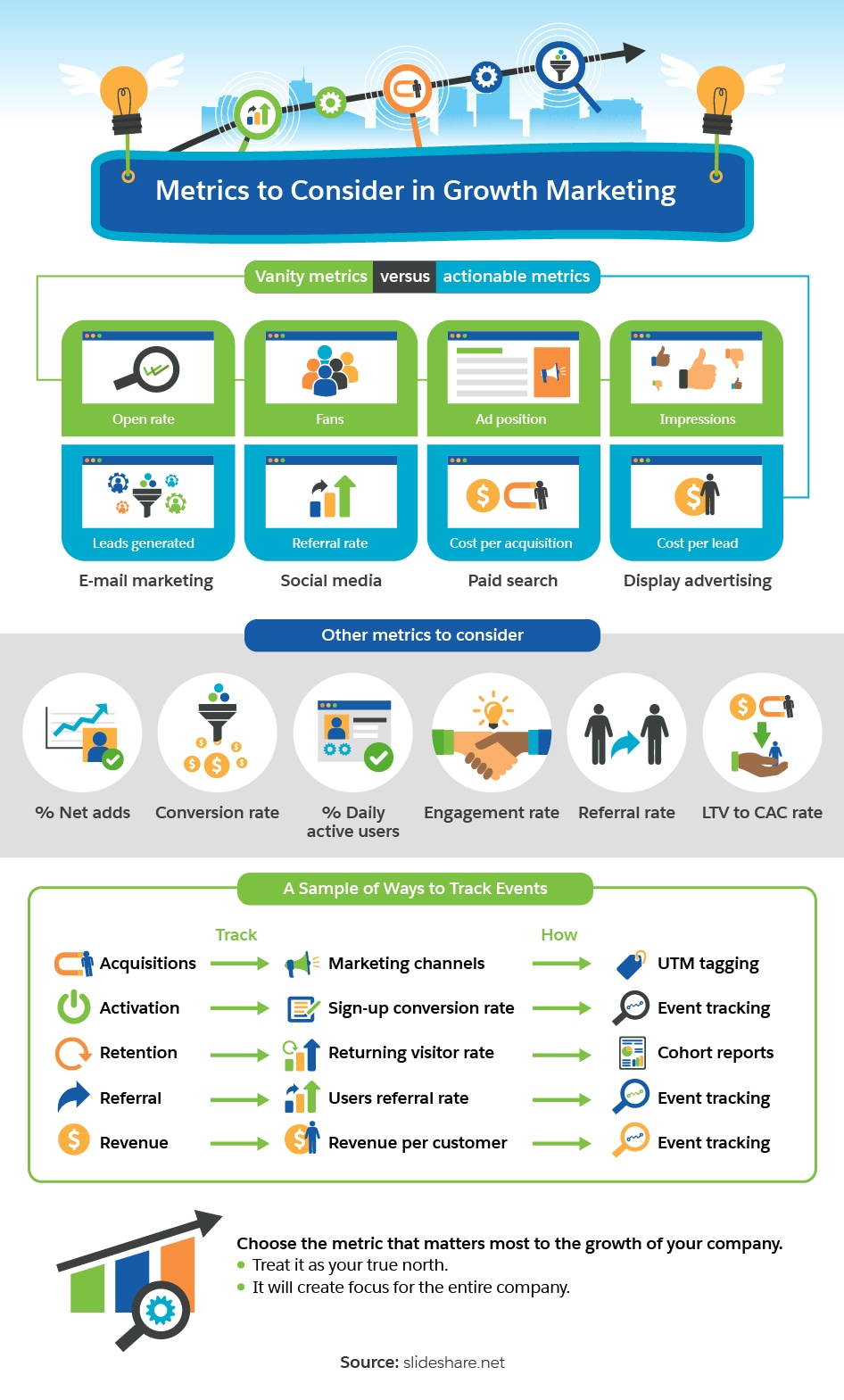A Small-Business Owner’s Introduction to Growth Marketing



Growth marketing refers to businesses growing exponentially as they discover the power of tailor-fitting a marketing strategy for their company using both sides of the brain: creativity and data-driven practices.
Kathryn Casna
Growth marketing: It seems self-explanatory. In fact, it almost seems redundant. Isn’t the very purpose of marketing to grow your business? You look for improvement or growth in metrics, such as the number of website visitors, leads, and customers.
Believe it or not, the term “growth marketing” actually refers to a very specific kind of marketing. It refers to businesses growing exponentially as they discover the power of tailor-fitting a marketing strategy for their company using both sides of the brain: creativity and data-driven practices.
So what exactly is growth marketing? How can small businesses use it to their advantage? Is it right for your company? Read on to find out.
What is Growth Marketing?
In its simplest form, growth marketing, also known as growth hacking, is marketing that is hyper-focused on, well, growth. Its very existence is a response to rapidly growing technology, a shrinking world, and a culture that seems to change on a daily basis. Growth marketer Sean Ellis says a “growth hacker’s true compass is north.” Bigger, better, and more are what it’s all about.
As a result, growth marketing is anything but old school. It differs from traditional marketing in that it uses modern tools and metrics to measure the performance of specific strategies and tactics as completely as possible. Different than old-school marketing, growth marketing is inherently tailor-fit to your company, and constantly evolves to fit changing customer attitudes, respond to industry events, and handle your competition. It’s completely dynamic.
In the past, marketers used generally accepted principles to guide their efforts, and worked creatively within those parameters. Growth marketing, however, depends on thinking outside the box. It’s highly experimental. It’s where marketing meets scientific theory.
A Quick Overview of Growth Marketing
- It pays attention to the flow of customers in and out of your funnel
- Hyper-focused on growth
- Works on the entire funnel, not just the marketing or sales sections
- “Because growth without retention isn’t growth.”
- “If a typical SaaS business loses about 2-3% of their customers each month to churn, the business must grow by at least 27-43% annually to maintain the same revenue.”
- Growth marketing, also known as growth hacking, relies on:
- Being nimble
- Thinking outside the box
- Measuring everything possible
- Analyzing and quickly acting on data

Growth marketers don’t build a marketing strategy to implement, because their strategy is to adapt to whatever seems to be working best. In order to know what’s working, they have to just get out there and get started. You could say it’s like throwing spaghetti at the wall to see if it sticks—if you then measured exactly how much each and every noodle stuck. Then, one at a time, you’d slightly alter cook time, the type of noodle, temperature, angle of the throw, and more to see how each affected noodle stickiness. But you still wouldn’t be done, because then you’d test the best settings of each element together and fine-tune further to eke out just a bit more stickiness. By the time you finished that, someone will have remodeled the kitchen with fresh wallpaper. So you’d start all over.
If it sounds like a never-ending process, it is. But that’s the point. Your business environment is constantly changing, and so are your offerings as a company. And they’re changing faster than ever before. If you decide on a marketing strategy that isn’t dynamic, in the way that the Don Drapers of the world did, you’ll be out of touch before your campaigns ever go live.
Elements of Growth Hacking
So what do you need to hack growth? More than ever before, marketing depends on technical savvy and the ability to gather, interpret, and act on data. So here’s what you’ll need:
- The ability to test everything. That means views, clicks, and visits, as well as time spent on web pages and how much is made over the customer lifecycle. Some things are hard to measure, like exactly how many points of contact a customer needed before making a purchase, but a growth marketer will measure everything he or she can.
- Robust data tracking solutions to accompany that testing.
- A team full of both creatives and analysts. They’ll need to work closely together to brainstorm, roll out, measure, and refine each and every strategy.
- The ability to think outside the box. Just because many companies succeed using tried and true formulas doesn’t mean there isn’t a better way to eke out a few more leads or improve your ROI by a few more cents.
- A willingness to commit to the long haul. Sure, “growth hacking” and “growth marketing” might sound like magical incantations that instantly improve your marketing. But as any programmer (the original hacker) will tell you, hacking is a long process where each small success builds on the next to get big results.
If you can roll with all that, growth marketing could be the greatest thing for small businesses since the internet.
Growth Marketing for Small Business
How can you get started implementing growth marketing in your small business? With so many variables to test and measure, and so many metrics that contribute to overall success, you could get lost in the possibilities. Here’s how to get started without losing your mind.
Step 1: Prioritize Ideas and Opportunities
Whether you hire an experienced growth hacker or take on the task of learning the trade yourself, you’ll come across tons of ideas for how you can improve your efforts. But that doesn’t mean you should act on all of them right away. That would be chaos to implement, and you wouldn’t know which strategy changed your metrics in which way. Instead, focus on tactics that:
- Have the greatest potential impact on your company. This means those that will have the greatest growth in revenue and your company’s KPIs, or Key Performance Indicators.
- Are the easiest to deploy and test. You want the greatest results, but not if you have to spend all your resources to achieve them—at least, not at first. Go for the low-hanging fruit in the beginning, then use your growth to fund exploration of more challenging opportunities.
- Are most likely to succeed. For example, if your team includes a skilled graphics designer, an experienced PR manager, or a phenomenal webmaster, go after opportunities than lean on these people for success.
- Take less time to test. At this stage in your efforts, you need feedback about what’s working—and what isn’t—fast. You need to understand the big picture as soon as possible so you can structure your next efforts accordingly.
Kev Kaye of Growthboks recommends dumping each of your ideas into a spreadsheet, then rating them for each of the above criteria. Add each rating into one overall score, and use that score to prioritize your efforts. Then knock them out one at a time.
Growth Hacking, Growth Marketing, and Traditional Marketing: Same Goals, Different Methods
- Growth Hacking
- Scrappy
- break things
- Revenue focused
- Startup focused
- Agile processes
- small teams
- Growth Marketing
- Tradittional Marketing
- Perfection over speed
- Big Budget cost center
- Awareness focused
- Unwieldy processes
- Big teams

Step 2: Scale It Up
Once you’ve tried out a few strategies, it’s time to start using them throughout your brand. One of the most important elements of successful growth marketing is the ability to scale up your efforts. If you’re a numbers geek or have a scientific mind, you may enjoy A/B testing blog titles. Sure, having a passion for figuring out what makes consumers tick is going to help make you a good growth hacker, but the science isn’t really the point. At least, an understanding of the science won’t in itself affect your bottom line. You have to use your knowledge and you have to use it in big ways. You’ve invested in learning what your consumers respond to, so make the most of it by scaling that knowledge up.
The best part about growth marketing is that you often learn about more than just marketing. You can learn how to improve the entire customer journey with tactics you can employ in sales, service, product development, and even packaging and delivery options. Hire additional support as needed, knowing you’re growing your business based on concrete, data-backed strategies and decisions.
Step 3: Simplify
As you learn more about growth marketing and what makes your customers tick, work on streamlining your efforts. Learn which metrics make the most difference for your bottom line, and hone in on them. Streamline your testing process by writing down procedures and invest in better tools that make rolling out changes instant and easy.
- Vanity metrics versus actionable metrics
- Email Marketing
- Open rate
- Leads generated
- Social Media
- Fans
- Referral rate
- Paid search
- Ad position
- Cost per acquisition
- Display advertising
- Impressions
- Cost per lead
Metrics to Consider in Growth Marketing
- Other metrics to consider include
- % net adds
- conversion rate
- % daily active users
- engagement rate
- referral rate
- LTV to CAC rate
- A Sample of Ways to Track Events
- Track
- Acquisitions
- Marketing channels
- How
- UTM tagging
- Acquisitions
- Track
- Activation
- Sign-up conversion rate
- How
- Event tracking
- Activation
- Track
- Retention
- Returning visitor rate
- How
- Cohort reports
- Retention
- Track
- Referral
- Users refferal rate
- How
- Event tracking
- Referral
- Track
- Revenue
- Revenue per customer
- How
- Event tracking
- Revenue
- Event tracking
- Choose the metric that matters most to the growth of your company
- Treat it as your true north
- It will create focus for the entire company

Is Growth Marketing Right for Your Small Business?
Growth marketing is the future of marketing. But is it the right move for your business right now? While growth hacking is all about the long-term (a marathon, if you will) it happens in sprints. You’ll do a whole lot of testing, then spend time implementing what you’ve learned across your organization. And because what you learn today could change next month, in order to take advantage of your investment, you’ll need to be ready to act on your findings right away.
Sometimes, you’ll get growth hacking results that your company simply can’t adapt to quickly enough. If, for example, as part of your A/B testing you end up with a huge influx of leads, but don’t have the sales team to nurture them into customers, you may miss out. And if you end up doubling or tripling your product orders, are you poised to fill them?
Prepare for Growth
Investing in growth marketing may require hiring new staff, guiding company culture in a new direction, and new equipment, software, or other tools. Before you do any of those things, make sure you’re ready to capitalize on your investment with these key steps.
- Line up additional suppliers, manufacturers, and other vendors to handle any overflow work.
- Streamline your sales and other department hiring processes so you can find great candidates faster.
- Ensure your board of directors and other executives are “all in” and ready to approve actions based on new discoveries.
- Choose tools and technology that grow with you so you can avoid retraining, setup, and other unnecessary costs.
Make sure your tools allow you to focus on your relationships with your customers. Use a cloud-based system for service, community management, and marketing. The right platform will help you set up A/B testing for everything from social media posts to email drip campaigns. You can gather data from dozens of metrics, and also compile, display, and interpret it. Make it easier to share and implement your findings across your organization, no matter how big or small.
Growth marketing is only as powerful as the technology behind it. With the right tools and people, you can find success in this very reactive, exciting marketing niche.






















